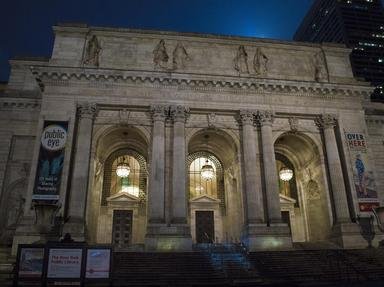Quiz Answer Key and Fun Facts
1. In Flannery O'Connor's short story, "The Life You Save May Be Your Own," what does the vagabond Mr. Shiftlet do to his new bride, Lucynell, on their wedding night?
2. Which of William Faulkner's novels, centering on the rape of Temple Drake, features a character named Popeye?
3. Peter Taylor's short stories draw heavily from his life experiences, although few as much as his story based on his trip with Robert Lowell to New York while they were students at Kenyon College to meet two women they hoped to romance. Which of the following stories closely follows the real story of the young men's ill-fated sojourn?
4. Match the name of this Robert Penn Warren poem, written in 1975, to this stanza:
"Look! Look! He is climbing the last light
Who knows neither Time nor error, and under
Whose eye, unforgiving, the world, unforgiven, swings
Into shadow."
5. William Styron's controversial novel, "The Confessions of Nat Turner," is a fictional first-person account by Turner of a slave rebellion in 1830 that killed almost 70 people and resulted in Turner's execution. True or false: Nat Turner describes sexual feelings for a white woman in the novel.
6. In Tennessee Williams' play of the same name, what is the glass menagerie?
7. Complete the opening line from Ferrol Sams' novel, "Run With the Horsemen": "In the beginning was...."
8. The central character in Eudora Welty's Pulitzer-winning novel, "The Optimist's Daughter," returns from Chicago to the South to be with her family in her father's dying days. What is her name, which she shares with a town in Mississippi?
9. In William Faulkner's novel, "As I Lay Dying," what character's name titles a chapter that has a single line: "My mother is a fish"?
10. Who was called the Poet Laureate of the Confederacy?
11. At what college is Pat Conroy's novel, "The Lords of Discipline," set?
12. In Margaret Mitchell's novel, "Gone With the Wind," how many different men does Scarlett O'Hara marry?
13. Lee Smith's novel, "Oral History," uses multiple narrators and dialect in a way mirroring Faulkner's narrative style in "The Sound and the Fury." Following this analogy, who is "Oral History's" Caddie Compson, the woman at the center of the novel that all the narrators speak about but the reader never hears from directly?
14. In Zora Neale Hurston's novel, "Their Eyes Were Watching God," which of Janie's husbands does the novel describe by saying, "He looked like the love thoughts of women. He could be the bee in her blossom, a pear tree blossom of spring. He seemed to be crushing scent out of the world with his footsteps. He was a glance from God."
15. What is the name of James Agee and Walker Evans' famous collaboration, a four-week long study of a Depression-era sharecropping family in the Deep South, that began as a Fortune magazine assignment and became a book-length narrative that continues to be one of the most important historical resources about the life and times of tenant farmers in the early 20th century?
Source: Author
rjchief
This quiz was reviewed by FunTrivia editor
Bruyere before going online.
Any errors found in FunTrivia content are routinely corrected through our feedback system.

